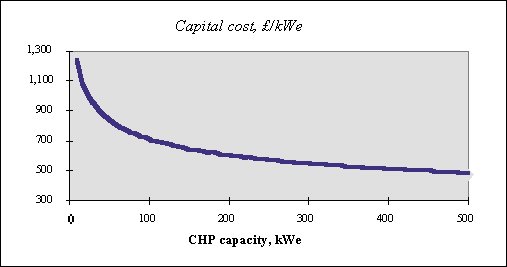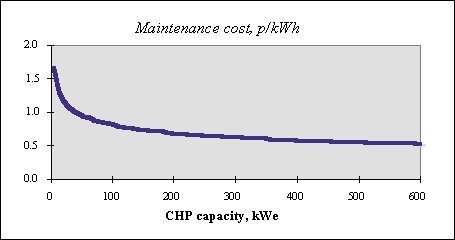In order to evaluate the economics of a CHP plant, the following main costs should be
considered:
![]() Installed (capital and installation)
Installed (capital and installation)
![]() Maintenance.
Maintenance.
![]() Running.
Running.
Whilst the capital, installation, and maintenance costs are significantly higher than for a conventional boiler plant, CHP can yield very considerable savings in running costs. If the right application is chosen, it can provide attractive economic returns on the additional investments.
In addition to these, other important factors in determining the cost effectiveness of an installation, are the value of the generated heat and power (which depend on the existing plant and tariffs), the pattern of operation (hours run), the accuracy of electrical and heat load profiles (Project Menu), and the sizing and design of the CHP plant.
Total Installed CostsThe total installed costs will basically depend on the:
![]() Supplier.
Supplier.
![]() Required size for the CHP unit.
Required size for the CHP unit.
![]() Level of control needed.
Level of control needed.
However, these costs are in fact more a function of unit size and site complexity than the
choice of equipment supplier. This way, unless an individual site has exceptionally demanding
installation requirements, the total installed costs per unit power will fall with increasing
unit size.
| Type of Plant | Spark Ignition Reciprocationg Engine | Compression Ignition Reciprocating Engine | Gas Turbine | Combine Cycle Gas Turbine | Back Pressure Steam Turbine | Pass Out Steam Turbine |
| Capital Costs p/kWe | 550-850 | 500-800 | 500-1500 | 500-700 | 600-2000 | 600-2000 |

Fuel is the main running cost, so choosing the optimum fuel is very important. In principle, a
CHP unit can run on any fuel that will drive a suitable engine. The fuel for a particular
application will be selected mainly on the basis of availability and price. It is preferable
to use the fuel which is the cheapest in terms of cost per unit of output from the CHP plant.
The unit cost of the fuel for CHP plant should be similar to that of the main boiler plant, or
there is the risk of offsetting the savings in purchased electricity.
Back to Top
The maintenance of CHP units is more expensive than conventional boilers. Careful assessment and consideration of maintenance costs are essential when calculating savings, as they can amount to 30% or more of the gross cost savings from CHP operation.
It is essential that proper comparisons are made between the systems being considered and to facilitate this, life cycle maintenance costs should be carefully established with the CHP unit manufacturer or system designer. The life cycle costs should include routine service and lubrication costs as well as top-end and complete overhaul costs, all on an annual basis.
| Type of Plant | Spark Igmition Reciprocating Engine | Compression Ignition Engine | Gas Turbine | Combined Cycle Gas Turbine | Back Pressure Steam Turbine | Pass Out Steam Turbines |
| Maintenance Costs p/kWh | 0.5-0.8 | 0.4-0.8 | 0.2-07 | 0.2-0.7 | 0.1 | 0.1 |
Current experience suggests that overall maintenance costs for small-scale CHP units are between 0.5 and 1.4 p/kWh of electricity generated (Fig. 2). However the actual figure will depend on the plant location, size, number of units and in-house resources.

Fig. 2 - Typical small-scale CHP maintenance costs versus unit size.
There are several financing options available when considering the financing of a CHP system.
The choice will essentially depend on capital availability and company accounting policy.
The three most common financing schemes are:
![]() Outright Purchase - direct purchase from the equipment manufacturer.
Outright Purchase - direct purchase from the equipment manufacturer.
![]() Equipment Supplier Finance - CHP company installs and maintains the plant free of charge.
The client pays the fuel and purchases the generated electricity at a reduced price.
Equipment Supplier Finance - CHP company installs and maintains the plant free of charge.
The client pays the fuel and purchases the generated electricity at a reduced price.
![]() Contract Energy Management (CEM) - leasing-based financial scheme agreed with a CEM company.
Contract Energy Management (CEM) - leasing-based financial scheme agreed with a CEM company.
Basically, maintenance responsibilities and costs vary between options. But commercial and
contractual terms and conditions can be made very complex.
A wide range of techniques can be applied to assess the economic feasibility of a CHP scheme.
Two commonly used methods are:
![]() Simple Payback - ratio of capital cost to annual saving.
Simple Payback - ratio of capital cost to annual saving.
![]() Payback using the Discounted Cash Flow Analysis - more sophisticated approach, where the
effects of future revenues and costs are accounted.
Payback using the Discounted Cash Flow Analysis - more sophisticated approach, where the
effects of future revenues and costs are accounted.
The calculation of economical parameters (such as the Payback) using the Discounted Cash Flow
Analysis is generally recommended, since it allows a more accurate appraisal of cost saving
measures, allowing for changes in monetary value over time, and also brings the various
component parts, with varying lifetimes, to a common and comparable base.
Back to Top